You definitely need more snake plants in your life and around your home. Snake plants, also known as sansevieria or mother-in-law’s tongue, are a popular, and especially easy to grow houseplant. But you don’t have to go out and purchase new snake plants, because snake plant propagation is an easy way to grow new plants from cuttings. Keep reading to find out how to grow more snake plants for your home and friends.
How do you grow snake plant cuttings? There are four basic methods of snake plant propagation:
- Snake plant propagation in water. You can cut off healthy leaves and regrow them in water.
- Snake plant propagation in soil. Root cuttings in soil by placing a leaf that you have removed directly in soil.
- Propagation by division. You can easily divide a snake plant in half.
- Propagation from rhizome. Underground stems can grow into new snake plants with the right conditions.
Are you ready to try to propagate your own snake plants? I hope you are because it’s easy and enjoyable to grow your own snake plants. Keep on reading to find out exactly the methods you can use and how to know which one is right for you.
If you’d like to learn how to propagate all your houseplants and keep them thriving year after year, check out my book, “Houseplants Made Easy”.
Propagating Snake Plant Cuttings In Water

The easiest means of propagating a snake plant is to root cuttings in water. This is a great use for those ‘off’ leaves that fall over and bend or break. It’s also a great way to use those extra leaves that you prune away from your snake plant when you want to adjust how it looks.
What you’ll need:
- Sharp knife or scissors
- Heavy glass, jar or vase
- Water
- Rooting hormone (optional)
Using a sharp knife or scissors, carefully snip off the leaf you want to propagate near the soil. The sharper and cleaner the cut, the better your results will be. If you like, you can dip your cutting into root hormone. Next, place the bottom portion of the leaf in water, covering about 25% of the leaf with water.
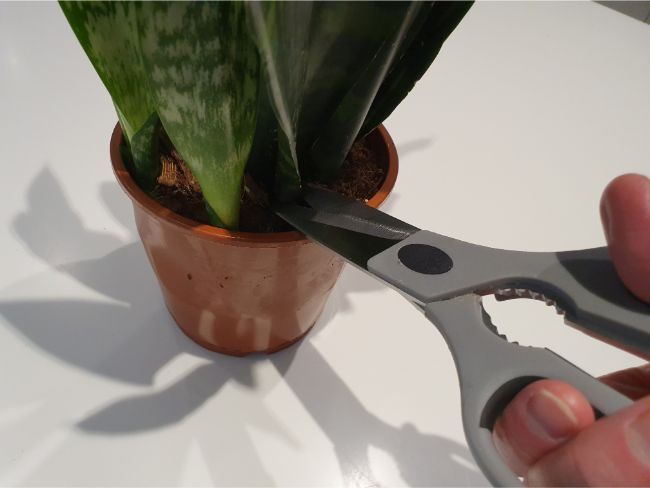
If your snake plant leaves are large, you can cut the leaf into sections, and place each section into water, as demonstrated above.
It is important to keep the leaf in the same orientation as it was when it was in soil. Snake plant leaves are highly polar, so it will only grow roots if the edge of the leaf that was closest to the soil is put in the water. If you get the orientation of the leaf the wrong way round, the leaf will not grow new roots.
I like to cut a V shape in the bottom of the cutting. This has a number of purposes and improves the success rate of my cuttings. It increases the surface area of cut edge to the water, it prevents the cut edge from pressing against the bottom of the glass or vase, and it also helps me identify the bottom end of the leaf, in case I get mixed up at any time.
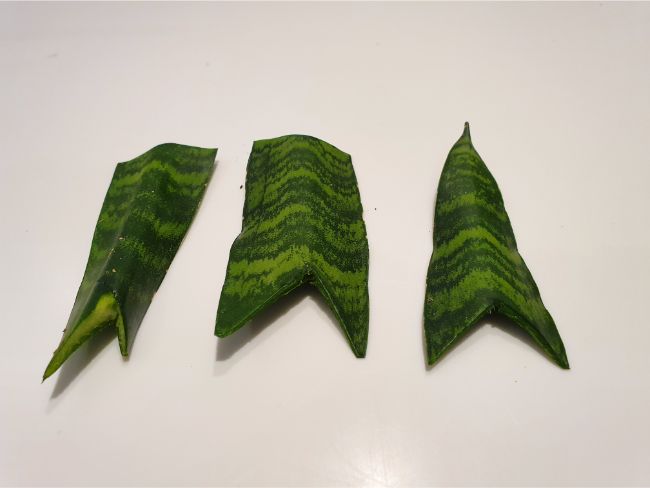
Snake plant leaves can be top heavy, so you will want a heavy vase or jar, such as a mason jar or even a tall flower vase. Keep the leaf in a warm room with lots of indirect light. Change the water in the glass or vase every week, or any time you see the water looking cloudy.
Be prepared for quite a long wait to see roots develop. It will likely take about two months or even longer for roots to sprout from your cutting. You may see some small growths or shoots starting from the roots, as well.
Once the roots sprout, you can plant your cutting in soil. You’ll want to plant the cutting as deep as the water line was on the leaf. Don’t worry about the small shoots. They’ll pop right up through the soil when they’re ready.
Although this method is easiest, it may take the longest, especially if the plant does not receive much indirect light.
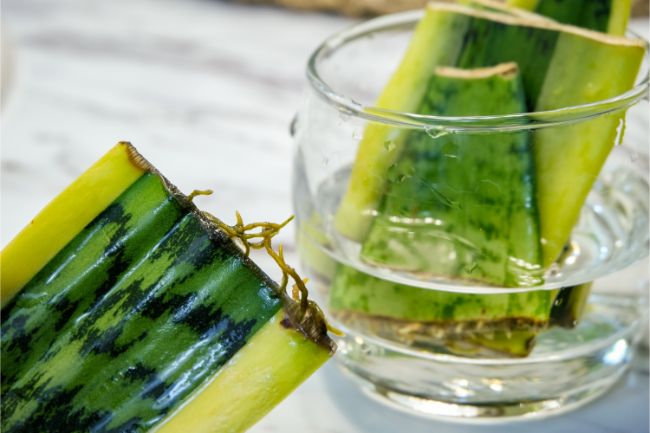
Propagating Snake Plant Cuttings In Soil
What you’ll need:
- Sharp knife or scissors
- Pot
- Succulent soil or other appropriate potting mixture
- Root hormone (optional)
You can get more cuttings from a single leaf if you root those cuttings directly in soil. Start with the leaf you want to propagate and cut it off close to the soil line with a clean and sharp knife. Then, using a very sharp knife, cut the leaf into pieces, each piece being a couple inches long.
Let the leaf pieces sit out for a few days until they begin to callous over. This will help prevent bacteria from the soil from getting into the leaf and causing rot, as with all succulents.
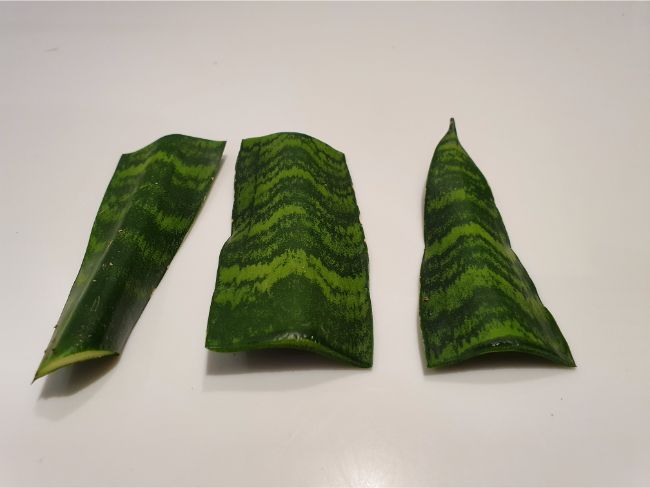
Make sure you remember which part of the leaf goes up and which part goes down. If you like, you can dip the bottom end of the snake plant cutting into rooting hormone powder.
Next, put the part that was close to the bottom of the plant, into well-draining soil. Succulent soil is a great choice for this, or a similar growing medium. Plants will begin to grow roots in about a month and will sprout new growth in about another month.
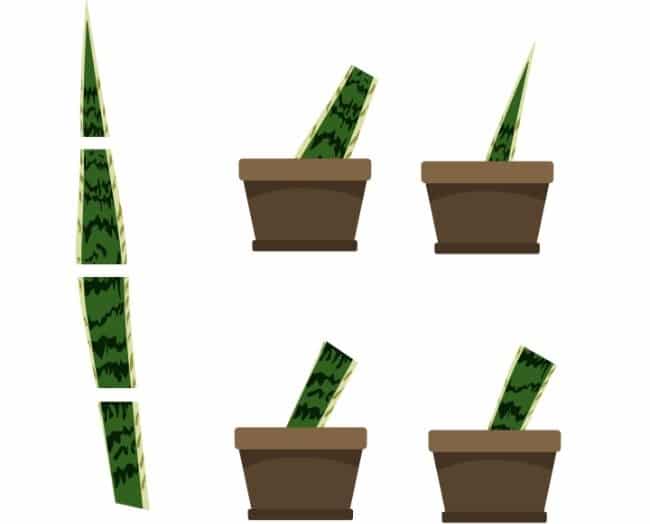
Snake Plant Propagation By Division
What you’ll need:
- Newspaper or space outdoors
- Clean, sharp knife or handsaw
- Enough clean pots for your divided plants
- Succulent soil or potting mixture
If you need more snake plants in a hurry, you can try propagation by division. This is a means of separating a single plant so that it becomes two or more plants. Gently lay your plant on its side and slide the plant out of its pot. You’ll probably want to put down some newspaper or do this outside.
Inspect the roots carefully and look where the rhizomes are. If your plant is smaller, you’ll probably only separate it in half, but if it is a large plant, you can separate it into more pieces. Using a handsaw or even sharp shears, cut the plant so that there are at least 3 rhizomes and one good, healthy leaf per section.
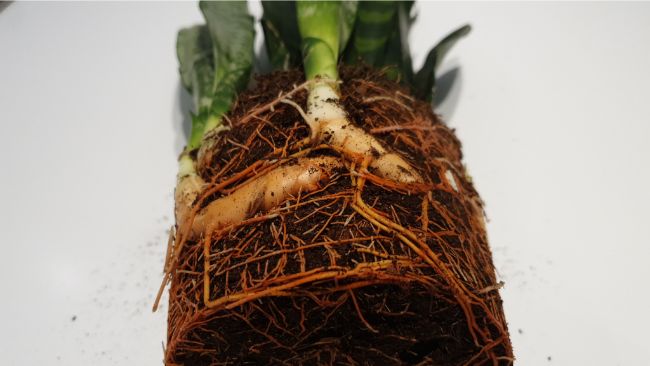
Make sure there are a couple of roots in each section, as well. If there aren’t, then your plant is not ready to divide and you probably should give it more time to grow more roots and rhizomes before you split it.
After you have split your snake plant, repot each separate plant into a fresh pot with succulent soil. Give each one a small drink of water and then do not water your plants again until the soil is thoroughly dried out.
Propagating Snake Plants By Rhizome
A rhizome is a stem that grows underground and horizontally. In snake plants, this rhizome will send off new shoots called pups. Even if you don’t have pups to grow into new plants, you can use the rhizome to grow new snake plants.
What you’ll need:
- Newspaper or outside space
- Sharp knife or shears
- Now pots for each rhizome
- Potting mixture or succulent soil
Carefully lay your snake plant on its side and slide it out of the pot. Look for some rhizomes under the soil in the root area. They are a whiteish looking stem that somewhat resembles cloves of garlic.
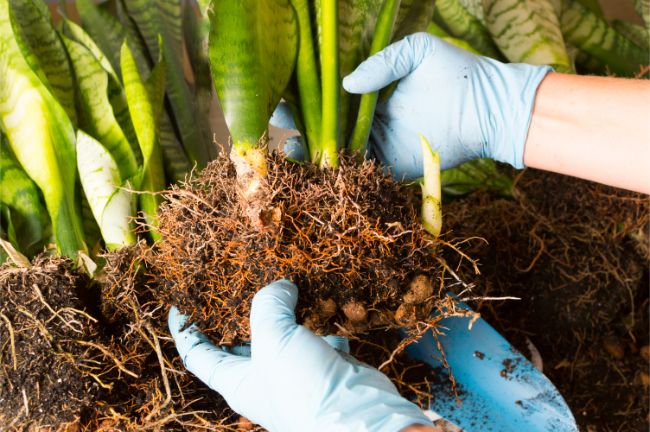
Using a clean sharp knife, cut off the rhizome from the base of the plant. Be careful not to damage the roots around it. Allow the rhizome to callous over for a few days, just like you would in soil cuttings.
Once a callous has formed, you can plant the rhizome in a new pot. Watch and wait for the new growth to appear.
The Best Conditions For Snake Plant Propagation
Not all snake plant cuttings are going to survive the propagation process. Even the best, most experienced growers lose cuttings for unknown reasons. You can increase your chances of success by providing optimum conditions for your cuttings.
- Bright, indirect light.
- The right pot
- Clean pots and utensils.
- The right soil medium
- The right amount of water
You may like to read my other article about snake plant care, which goes into all the detail of ensuring your snake plants are thriving and happy.
Bright, Indirect Light
Established snake plants are very forgiving and can tolerate a wide variety of conditions. But cuttings need a little extra care to ensure success. For faster growth, keep your cuttings in a room that has bright indirect light. This will help your roots to grow in faster. Low lighting may cause the roots to take months to grow.
The Right Pot
Terracotta pots are great for snake plants and any succulents because they are porous and allow the soil to dry more thoroughly. Since snake plants are prone to rot when they are over-watered, terracotta makes the best choice.
Snake plants need good drainage, so always choose a pot with a drainage hole in the bottom. Also, a heavy pot works best because tall snake plants can become top heavy.
Clean Pots And Utensils
When cutting snake plants to propagate them, you are inflicting a wound upon the plant. This opens the plant up to bacteria and fungi, which could kill the plant. Wash all pots and utensils prior to propagating to diminish the chance of bacteria harming your cuttings. Some growers will go so far as to sterilize the knife or shears they use to cut the plant.
The Right Soil Medium
Snake plants and other succulents do not like to be overwatered. This will cause rot and mushiness in the leaves and roots. You’ll need to use a soil medium that drains well and dries out thoroughly in between waterings.
You can purchase succulent soil for this purpose or make your own by adding extra perlite to regular potting soil. You could also grow snake plants in soilless potting mix, which is generally made up of perlite, vermiculite, and coarse sand, and even sphagnum peat moss.
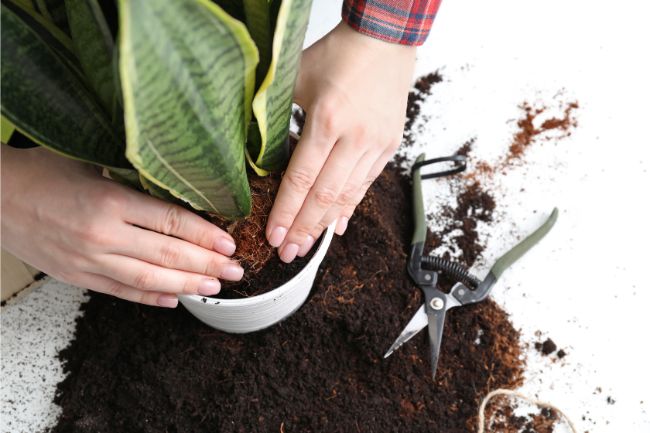
The Right Amount Of Water
When dealing with succulents of any sort, especially snake plants, you are more likely to cause problems by overwatering than by underwatering. These drought-tolerant plants thrive on neglect, so if you forget to water them, they’ll most likely be just fine.
However, overwatering can cause a host of problems such as rot, fungi, and mushiness in the leaves and roots. Only water the plants when the top two to three inches of soil is completely dry. Then water thoroughly, until water runs out the drainage hole. Wait until the soil is dry to water again.
The Right Temperatures
Snake plants grow well indoors because they are tropical plants. They like temperatures between 60-80°F (16-27°C). If temperatures drop below 50°F (10°C), the plant may yellow and die or turn brown at the edges and tips of the leaves. A snake plant cannot withstand frost or freezing temperatures.
What To Do When There Isn’t Any Growth
If there isn’t any visible growth, try to remember the old saying: “If it ain’t broke, don’t fix it.” Just because you don’t see growth, doesn’t mean the plant is dead. If you have followed all the directions and your snake plant seems like it has completely stalled, you might be wondering if it is dead or alive.
Don’t panic! Sometimes, transplanting snake plants or their cuttings will cause them to go dormant for a period of time. This can last weeks to months, so if it isn’t dead, don’t throw it away. Just wait it out and make sure you are providing optimum conditions for your cuttings.
You can tell your snake plant is dead if the leaves have all turned yellow, it is mushy, or the roots are mushy. If there is green the plant may still be viable if you can cut away the dying parts of the plant and repot it.
Another reason for a lack of growth may be that the plant is growing roots under the soil. Sometimes, snake plant cuttings will need to put down a large amount of roots before you see growth above the soil. If your cuttings have been stalled for several months, you may want to check for root growth. Or, you can just wait and see if the plant is still alive.
Snake plants are slow growing plants. The last reason that you may not see growth for a long period of time is that snake plants just grow more slowly than a lot of other plants.
Contributing factors to this can be inadequate lighting or poor soil. Underwatering may cause the plant to go dormant rather than die. Check the conditions of your plant if you feel it isn’t growing fast enough.
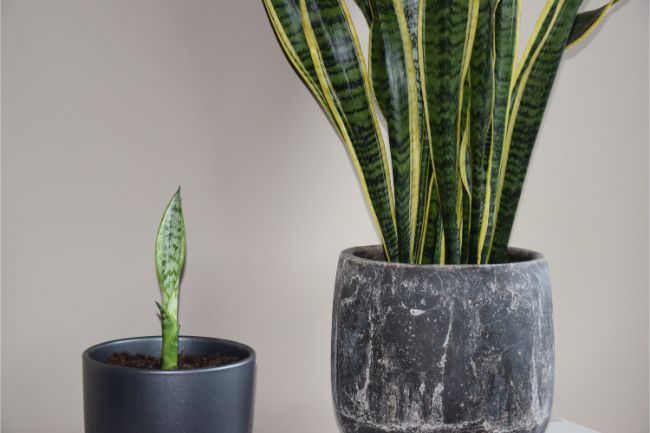
Snake Plant Propagation Problems
Sometimes, propagation doesn’t go as planned, which is why it’s always a good idea to propagate more cuttings than you actually need. You may notice that the edges or tips of your leaves turn brown.
This is most likely because the temperature in the room is too cool. Rarely, a snake plant doesn’t get enough water. When this happens, you can tell because the leaves of your plants will begin to look withered, curled or shriveled.
Rotting and root rot are one of the most common problems when propagating this plant. You may notice the leaves start to have what look like wet spots, which will slowly spread to the entire leaf. Sometimes, the cuttings can recover and continue to grow.
Other times, it will lead to the demise of your plants. Typically, rotting begins at the roots where you cannot see it. This is due to overwatering. You can prevent root rot by allowing the plant and soil to thoroughly dry out in between waterings.
If you do notice there is root rot, remove the plant from the soil. You can cut away the rotting, mushy parts of the roots and plants with a clean, sharp knife. Then replant the snake plant in fresh, dry soil. Give the plant some time to acclimate before you water it again.
Snake plants are susceptible to some forms of plant diseases and pests, which may affect your cuttings. For best results, always start with a healthy snake plant. A dying snake plant is not a great candidate for propagation, although it might be worth a try if you are desperate to save a particular plant.
Although snake plants are very hardy, spider mites and mealybugs can injure and weaken an infected plant. Mealybugs can be removed by hand and spider mites can be easily washed away with water.
Anther common problem with sansevieria is fungal disease. Fungal disease is often caused by too much humidity around the leaves. Keep the leaves dry and do not overwater your snake plant to avoid potential fungal diseases.
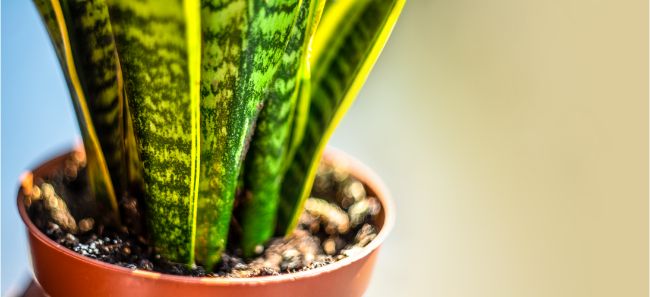
Problems With Leaf Cuttings On Variegated Snake Plants
Variegated snake plants are beautiful with yellow vertical stripes gracing the edges of the leaves. However, if you attempt to propagate these variegated snake plants by doing leaf cuttings, they will most likely revert to being an all green plant. If you want more variegated snake plants, you will be better off to divide the original plant than to attempt to propagate it by leaf cuttings.
How Long Does It Take To Propagate A Snake Plant?
Snake plants are very slow-growing plants. It will easily take at least six to eight weeks just to see root growth. It may even take two to three months to see any solid roots if your snake plant cuttings are growing in a low-light area.
It may take another four to eight weeks after that for your snake plant to show growth above the soil line. Have plenty of patience with the growth of your snake plant and don’t feel discouraged if it takes a long time to grow.
Why Would You Want To Grow More Snake Plants?
Propagating snake plants is a wonderful way to grow as many new plants as you like. It’s fascinating to watch the cuttings start to grow roots and develop into young plants. My kids really enjoy helping me propagate and look after all my houseplants, and watching the new plants grow.
Another reason to grow snake plants is that they are easy to keep alive. These plants thrive on neglect, and if you can nurse them past the cutting stage they will live long and healthy lives to bring beauty to your home.
The last reason to propagate snake plants is to share them with friends and family. Who wouldn’t love this beautiful and hard to kill plant? Follow these easy directions to enjoy your snake plant – and many more – for years to come.



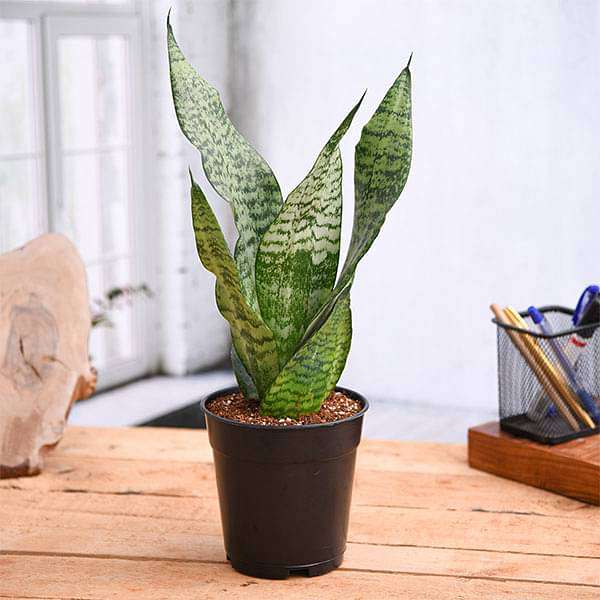
:max_bytes(150000):strip_icc()/GettyImages-1268045137-521346e9bf3243b69539e1f9a3f4ce4e.jpg)





